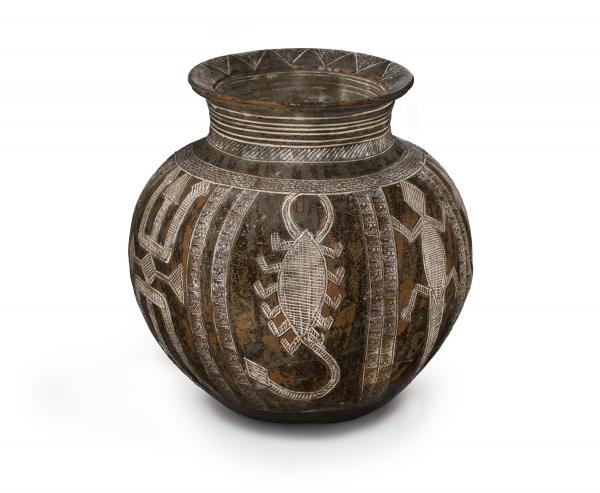Ladi Kwali was a Nigerian artist renowned for making exquisitely incised ceramic vessels using the forms and motifs of her native Gwari region. Her blending of Indigenous and European traditions, combined with her impact on several generations of artists in Africa and abroad, makes her one of the most deeply influential African ceramic artists of her time.
From a rural area near present-day Abuja, Kwali learned to make pottery from her aunt using the traditional coiling method with local clays and cassava starch in the incised decorations. Her work became well-known regionally, and graced the home of the emir of Abuja. Michael Cardew, a revered British potter who traveled around Nigeria in 1950, admired these pots in the emir’s home and invited Kwali to work at the newly built Abuja Pottery Training Centre (since renamed the Ladi Kwali Training Centre in her honor). There, he introduced her to the potter’s wheel and a new range of clays and glazes. Kwali was a standout trainee, and eventually became an instructor.
Kwali preserved the techniques and motifs from her familial Gwari traditions, making cooking pots, tureens, bowls, and water jars like this one—the most desirable form because of its broad surface area. However, she used new, high-firing clays and porcelain slips to give her pieces durability and a shimmery, almost iridescent luster. Like much Nigerian pottery, the pieces have beautifully incised decoration. While typical Nigerian pottery features simple geometric designs, the incised motifs on Kwali’s pieces record the natural world of northern Nigeria, including fish, birds, scorpions, and lizards.
In the late 1950s, Kwali’s work was shown in Europe—the Victoria & Albert Museum’s example was acquired in 1958—and she began to receive international recognition. Kwali pots were the quintessential Nigerian diplomatic gift and Kwali herself became a national hero—she became a member of the Order of the British Empire (OBE) in 1962, an Officer of the Order of the Niger in 1981, and for the past 50 years, her image has graced the 20-naira Nigerian banknote. Most importantly, she inspired many artists, including the celebrated Kenyan-British potter Magdalene Odundo.
As the art world has increasingly acknowledged the contributions of Black and women artists, Ladi Kwali’s work and her influence on a generation of artists have been recognized and celebrated. This unique, spectacular water jar, featuring Kwali’s quintessential crosshatching and animal and vegetal motifs, is an unsurpassed example of her work.
During our 38th annual Collectors Committee Weekend (April 27–28, 2024), members of LACMA's Collectors Committee generously helped the museum acquire 10 works of art spanning a breadth of eras and cultures. Read more about all the acquisitions.



